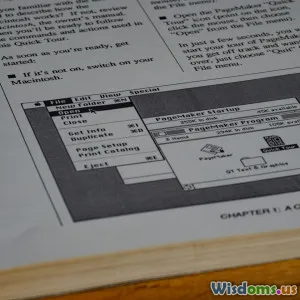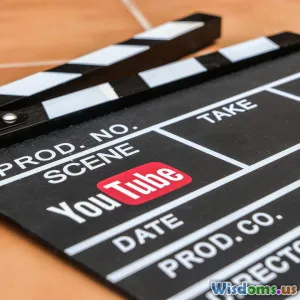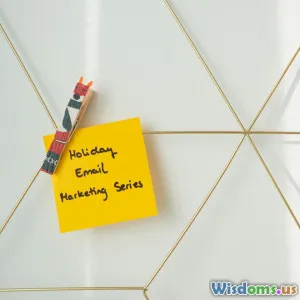
How to Craft Advertising Copy People Cannot Ignore
13 min read Unlock actionable strategies to create magnetic advertising copy that leaves a lasting impression and drives engagement. (0 Reviews)
How to Craft Advertising Copy People Cannot Ignore
Advertising is everywhere—cluttered social media feeds, crowded billboards, and our overflowing email inboxes. The challenge for marketers is not just to be seen, but to be remembered. To be acted upon. Yet, most ads vanish into a blur. What separates the magnetic messages from the forgettable? The answer lies in the art and science of advertising copywriting.
In this comprehensive guide, you will unlock time-tested principles, psychological insights, and real-world strategies to craft advertising copy that commands attention, inspires trust, and drives results. Whether you’re an entrepreneur, marketer, or creative professional, mastering these techniques can be the difference between wasted ad spend and runaway campaigns.
Table of Contents
- The Psychology of Why We Notice Ads
- Master the Headline: The Gatekeeper of Attention
- Speak to a Single Powerful Emotion
- Activate the Reader's Imagination with Storytelling
- Clarity Over Cleverness—But Not at the Cost of Blandness
- Make the Value Unignorable: The Unique Selling Proposition (USP)
- Evidence, Authority, and Trust Builders that Convert
- Compelling Calls-to-Action: Tell Them What to Do
- Testing, Iteration, and Real-World Examples
- [Conclusion: From Good to Unforgettable Copy]
The Psychology of Why We Notice Ads
Every day, the average American encounters over 5,000 ads. Studies by Yankelovich Consumer Research found that, even back in 2007, we saw up to 5,000 ads daily—and the number has only grown in the age of mobile and programmatic marketing.
However, according to marketing expert David Ogilvy, "Only one out of five readers gets beyond your headline." What makes that single ad outshine its competitors?
Key Psychological Triggers:
- Novelty: The brain is wired to notice new or unusual stimuli. Think of the first car your friend drives in with butterfly doors; your head snaps around.
- Relevance: People tune into their own problems and aspirations. If your ad mirrors their hopes or pain, you’ve captured attention.
- Emotion: Neuroimaging studies show decision-making isn’t “rational”—emotion is always involved. Emotional content is 2x more likely to be shared (Harvard Business Review).
- Visual Anchors: Eye-tracking studies prove visual contrast and images heighten attention, but what you write sticks deeper (source: Nielsen Norman Group).
Master the Headline: The Gatekeeper of Attention
The headline is the entry point. If it fails, everything else collapses.
What Makes a Headline Unignorable?
- Specificity: State clear benefits (“Save $500 This Year with Simple Budget Hacks” beats “Tips to Save Money”).
- Curiosity: Tease surprising info (“Most Copywriters Ignore This Powerful Word—Don’t Be One of Them”).
- Urgency: Imply time sensitivity (“Limited-Time Offer: Get 40% Off Until Midnight!”).
- Relevance: Directly address the reader (“Tired of Being Overlooked? Here’s How to Stand Out at Work”).
Real-World Example
Apple’s legendary “Think Different” campaign didn’t describe the product, but positioned Mac users as visionaries—a powerful, memorable mantra. Compare it to the generic “Best Personal Computer”—one ignites the mind, the other fades away.
“On average, five times as many people read the headline as read the body copy.” — David Ogilvy
Checklist for Irresistible Headlines:
- Does it speak directly to the audience’s needs or desires?
- Is it concrete and specific?
- Is it intriguing enough to demand a second look?
Speak to a Single Powerful Emotion
Advertising is fundamentally about feelings. Research from the Institute of Practitioners in Advertising shows emotional campaigns outperform rational ones by a factor of two (in terms of profitability).
Map the Emotional Landscape
- Fear: Insurance ads (“Are you really covered for the unexpected?”)
- Aspiration: Fitness gear (“Unleash your best self this summer.”)
- Trust: Bank promotions (“Your money, insured, and in your control.”)
- Belonging: Social media networks (“Find your tribe—join now.”)
- Relief: Tax software (“Never stress over taxes again.”)
How to Find the Right Emotion
- Know Your Audience: Dive into reviews, forums, customer service calls. What do they care about most?
- Choose One Emotion: Great copy hammers a single feeling instead of a scattergun approach.
- Embody It in every line: Don’t just mention “fear of missing out” (FOMO)—paint what it feels like.
Example: Instead of “Plan your vacation now,” try “Imagine the smile on your child’s face as you feast at the world’s happiest place. Don’t let another year slip by.”
Activate the Reader’s Imagination with Storytelling
Human brains are storytelling machines. We relate to stories, not sales pitches.
The Power of Mini-Narratives
Consider Procter & Gamble’s classic: “Thank you, Mom.” This campaign told the story of Olympic moms behind the medalists, weaving a narrative far beyond detergent. Sales spiked and brand affinity soared.
How to harness storytelling:
- Start in medias res: Jump right into the action. “Your phone shatters. You hold your breath—is everything lost?”
- Use relatable characters: Replace generic “user” with “Sarah, a busy mom of two who dreams of a tidy home.”
- Include conflict and solution: Don’t bury the customer’s problem and resolution.
“Marketing is no longer about the stuff you make but the stories you tell.” — Seth Godin
Clarity Over Cleverness—But Not at the Cost of Blandness
There’s a common pitfall: mistaking ambiguity and wittiness for ingenuity. A clever pun isn’t effective if it’s misunderstood. Clarity always wins the initial attention war.
However, clarity need not be dull. Vivid language, punchy verbs, and visual detail sharpen your message.
Before and After: The Power of Precise Language
- Before: “Revolutionary beverage for a fresher feel.”
- After: “Recharge with a sparkling lemon boost—just 5 calories!”
The after paints a sense-based scenario; the product is concrete.
Practical Tip:
Write as if you’re talking to a smart friend. Skip jargon but keep personality.
Make the Value Unignorable: The Unique Selling Proposition (USP)
Legendary copywriter Rosser Reeves coined the term USP—what sets you apart, expressed as a tangible benefit for the customer.
Consider these famous USPs:
- FedEx: “When it absolutely, positively has to be there overnight.”
- Domino’s Pizza (historic): “Fresh, hot pizza, delivered to your door in 30 minutes or less—or it’s free.”
Crafting a USP Your Audience Can’t Ignore:
- It solves a specific, meaningful problem.
- It’s defendable—no one else can say the same (at least not credibly).
- It’s instantly understandable.
Formula: For [audience], who [problem], [brand/product] is the [category] that [unique benefit].
Example
For busy professionals who hate red-eye flights, Silk Airlines is the only regional airline that guarantees a full night’s sleep with private comfort cabins.
With clarity and uniqueness, your value becomes impossible to glaze over.
Evidence, Authority, and Trust Builders that Convert
In an era of skepticism, trust seals the deal. Backing your claims turns curiosity into conviction.
The Most Powerful Proof Elements:
- Data & Numbers: “4x better stain removal.” Notice how numbers make benefits seem tangible.
- Customer Testimonials: Real voices of happy users, especially with name/photo/video, build empathy.
- Awards & Endorsements: “Voted #1 by Consumer Reports.”
- Demonstrations/Case Studies: The “Will It Blend?” YouTube series turned industrial blenders into viral sensations by blending iPhones and more.
According to Nielsen, 92% of consumers trust earned media (recommendations, testimonials) over all other forms of advertising.
Tip: Try using a “reason why” close—explain why your offer is possible (“By cutting out middlemen, we can pass savings directly to you…”).
Compelling Calls-to-Action: Tell Them What to Do
You’ve got their attention and interest. Don’t let it slip through the cracks of vague calls-to-action (CTAs).
Best Practices for Action-Oriented Copy
- Remove ambiguity: Specify what’s next (“Start your free 14-day trial” vs. “Click here”).
- Include benefit: “Download your free toolkit and reclaim 2 extra hours a day.”
- Inject urgency: “Only 50 spots left—reserve yours now!”
Real-Life CTA Examples
- Spotify: “Get Premium Free”
- Grammarly: “Start Writing—it’s Free!”
- Duolingo: “Learn a New Language in 5 Minutes a Day.”
Keep your call simple, specific, and rooted in value.
Testing, Iteration, and Real-World Examples
Even masterfully written ads face uncertainty until tested in the real world. Smart advertisers treat copy as a living, evolving experiment.
The Power of A/B Testing
- Create two (or more) versions of your ad copy.
- Change one variable at a time (i.e., headline, CTA).
- Launch to similar audiences, measure clicks, conversions, etc.
Case Study: Unbounce found simply swapping a CTA from “Start Your Free Trial Today” to “Start My Free 30-Day Trial” boosted clicks by 90%. The first was generic; the second felt personal.
What to Test:
- Headline focus (problem vs. solution oriented)
- Degree of specificity (details vs. big picture)
- Amount and style of proof or testimonials
- CTA language and placement
Learn from the Memorable
- Nike: “Just Do It.” Short, emotional, audacious.
- Dollar Shave Club: “Our Blades Are F***ing Great.” Disarmingly honest language launches a $1B business.
- Old Spice: “The Man Your Man Could Smell Like.” Humor and identity—people remember it a decade later.
Analyze successful campaigns—then experiment, adapt, and optimize for your own audience.
Conclusion: From Good to Unforgettable Copy
Mastering unignorable advertising copy is a dynamic blend of psychology, creativity, and empirical testing. It’s about:
- Grabbing attention with relevance, clarity, and surprise
- Engaging emotions—empathy, desire, fear, joy
- Painting vivid, persuasive stories that linger in minds
- Backing claims with tangible proof
- Sparking prompt action with clear, powerful CTAs
- Evolving every word by measurement and learning
The most impactful copy isn’t just “seen”—it’s felt and acted upon. Whether you’re writing your next Facebook ad, billboard, or email campaign, let these proven principles guide your way from the forgettable to the unforgettable.
Ready to put them into practice? Pick one principle and start your next campaign—your words can be the edge that invites a click, a share, or a sale. Make them impossible to ignore.
References
- Harvard Business Review: "The New Science of Customer Emotions"
- Nielsen Norman Group: "How People Read Online: New & Old Findings"
- Ogilvy on Advertising by David Ogilvy
- Institute of Practitioners in Advertising: "The Long and the Short of It"
- Unbounce Conversion Case Studies
Rate the Post
User Reviews
Popular Posts

















